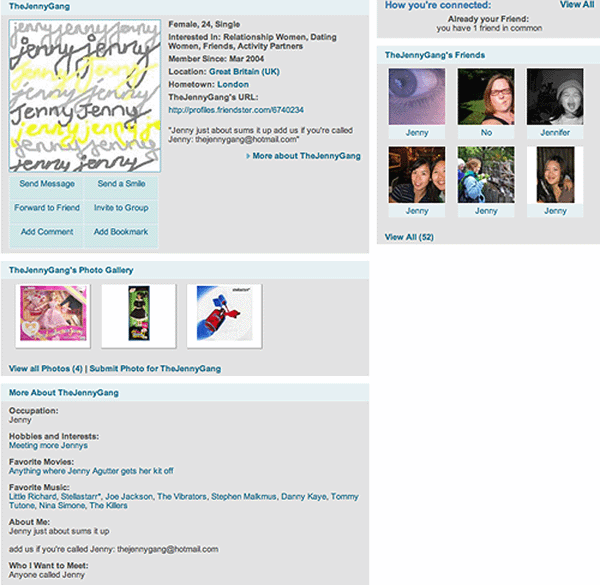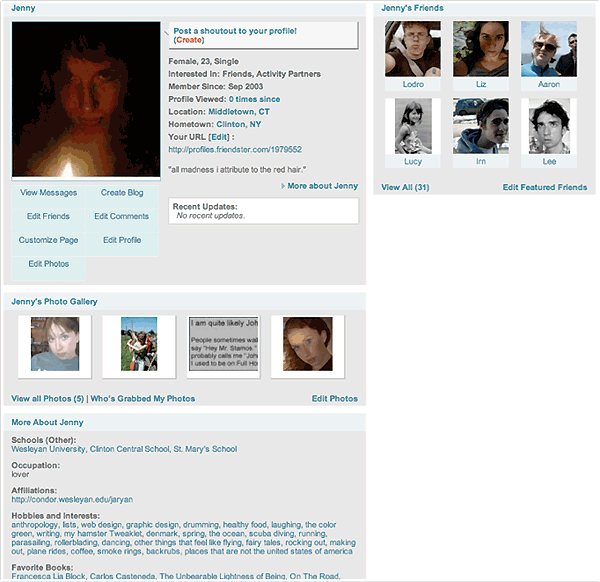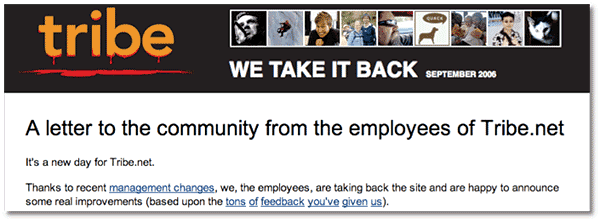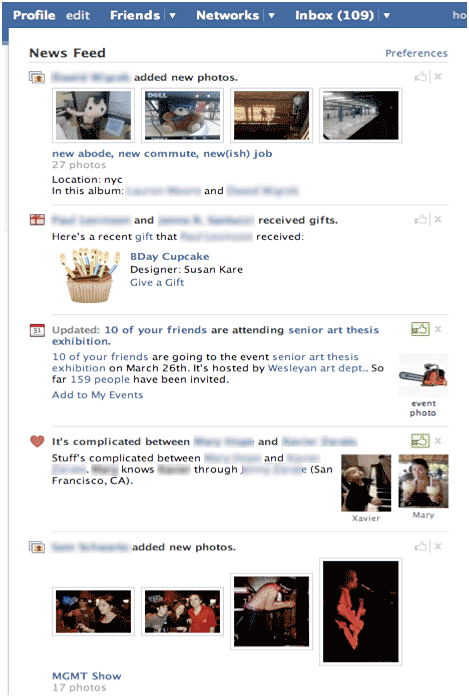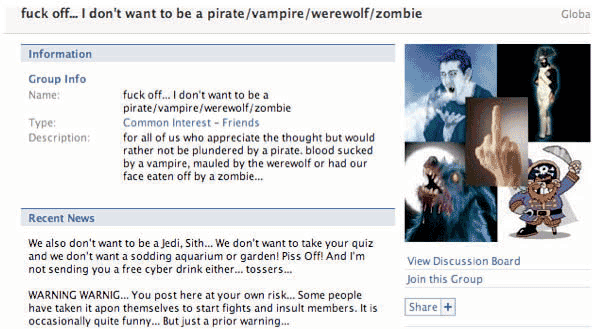|
By the early 1990’s, the concept of “the virtual community” had penetrated popular imagination. Hobbyists, visionary entrepreneurs, and venture capitalists alike saw the World Wide Web as a nebulous world full of possibilities and unpredictability, a new frontier for creativity, community and profit. Though there were many failures, the first successful Web-based communities laid the foundation on which later mainstream social networking sites would build. These early formations strove to establish trust among their users in a variety of ways: implementing protective features to regulate online communication; efficiently providing needed services within geographically-bound communities; and allowing users to draw in their offline relations and articulate connections online, effectively expanding their online social networks to include friends of friends with whom they might otherwise have lost touch. Contemporary online social networking sites combine a variety of components that distinguished several earlier forms of online “communities.” Some of the most popular early web services consisted of online matchmaking, classified ads, and virtually establishing one’s offline relationships. An examination of the origins of MySpace, Facebook, and Tribe suggests that three prior sites substantially influenced the current state of online social networking: Match.com, Craigslist, and SixDegrees.com. The shared origins of all of these sites are of notable importance. From the WELL to Friendster, Tribe to MySpace and Facebook, the creators of these online social networks inherited a geographic and ideological legacy stemming from the imagined “frontier” of the American west coast, California in particular. The “dot com” frenzy of the early 90’s took hold in Silicon Valley, much as Hollywood had been the birthplace of cinematic developments decades earlier. However, the “bottom-up” business model that drove the development of computer technologies was a significant shift in the history of communications media (Briggs & Burke 2005: 224). Craigslist, founded in 1995 by Craig Newmark, was inspired by the community-based nature of the WELL and Usenet newsgroups. What began as simply an e-mail listserv for events in San Francisco has since evolved into the largest classified ad system in the world. Visitors to the site may browse, upload, and respond to posts about “jobs, housing, goods, services, romance, local activities, advice - just about anything really (Craigslist n.d.).” Though Craigslist was incorporated for-profit in 1999, Newmark has staunchly resisted commercial exploitation of the site, advocating human survival through cooperation in the face of “kleptocrats and sociopathic organizations that have the almighty dollar as their only goal (McHugh 2004).” For purposes of moderation and authentication, there are modest fees for job postings in eleven major U.S. cities, as well as for brokered apartment listings in New York. To this day, Craigslist, which now serves over 450 cities worldwide, has remained primarily text-based (although posters may upload photos in the “housing,” “for sale,” and “personals” sections) and ad-free (Craigslist n.d.). Match.com, one of the first online dating sites, was launched in 1995 with the sole purpose of bringing the popular “personals” segment of newspapers online. The site allows singles to create personal profiles and communicate with potential romantic partners. “I had observed that in the Bay Area personals there were many more men advertising than women,'' founder Gary Kremen said. ``So I realized two things -- you had to get gay men and women on the service (Angwin 1998).'' While anyone can become a member, create a profile, and search for potential matches, the capacity to send and receive e-mail is limited to paying subscribers. Match.com’s consumer-oriented model transformed the world of dating by providing a safe and secure way of meeting other singles online, and quickly rose in popularity. Membership peaked in 2004, with over 20 million singles registered on the site. The emergence of online social networks based in users’ pre-existing offline relationships began in 1997 with the creation of SixDegrees.com, inspired by the 1929 theory of Frigyes Karinthy that anyone on earth can be connected to any other through a chain of six acquaintances. SixDegrees.com allowed users to provide their names, as well as create lists of acquaintances and friends who would then be invited to join the network. Users would then be able to view other users up to six degrees of separation, and communicate with members within three degrees of separation. Membership peaked in 1998 with over a million members. Despite its engaging premise, the site quickly declined in popularity, due to both the limited number of people using the Internet at the time as well as a lack of new interactive features. Nevertheless, SixDegrees.com set a new precedent for ego-centric online communities, as opposed to the interest-centric mailing lists and web forum communities before. In the decade since, online social networks have proliferated to such an extent that they are now among the most visited sites on the Internet. Friendster, the first of these sites to achieve mass popularity in the summer of 2003, was predicated on SixDegrees.com’s tactic of linking members to one another through expanding viewable networks of friends-of-friends. It original premise was to compete with popular matchmaking services, particularly Match.com. As such, activity on the site was primarily geared toward romance; members could post “Testimonials” on the Profiles of their Friends, which helped establish their trustworthiness and reputation for potential romantic interests. Friendster’s early users were predominantly gay men, bloggers, and Burners in their twenties (boyd, 2004). The site’s rapid decline in popularity among its early core groups was due in large part to a dramatic increase in surveillance of its members, a response to the popular trend of creating fake Profiles. Nicknamed “Fakesters,” such Profiles consisted of theatrical, interactive virtual play [19]:
As conflict between serious networkers and playful Fakesters heightened, Friendster began deleting the Profiles of putative Fakesters en masse, thus alienating its core user base and drastically reducing its popularity (boyd and Heer 2006: 9). It has since become a veritable graveyard of abandoned online identities; however it undoubtedly set the stage for sites such as Tribe, LinkedIn, and MySpace, which were all initially developed as competitors to Friendster.
In July of 2003, as Friendster’s popularity was peaking, Tribe was introduced to the Internet community. Its San Francisco origins are still evident today, as this particular local network remains the most populated and active. The site, which emphasizes local networks organized by city, allows users to buy and sell items, rate restaurants and other establishments, and rummage through job postings and housing ads. Members can establish trustworthy reputations by creating personal Profiles, joining “Tribes” based on shared interests, and connecting to friends. As the site’s history has not been articulated in any comprehensive manner, I contacted co-founder Paul Martino, resulting in an online chat through Instant Messenger later that week. “The original thesis of Tribe,” Martino told me, “was to marry Friendster and Craigslist- or as one of our focus group members said, ‘Craigslist with a face’"[21]. In articulating the origins of Tribe’s demographic base, Martino says, “to some extent Tribe was ‘captured’ by the Burning demographic.” For this reason, Tribe never became mainstream in the way MySpace did, instead becoming a niche site for displaced Fakesters, Burners, and a collective of “New Age” spiritual seekers. To this day, it remains relatively unknown to most of those with whom I’ve discussed online social networking. MySpace entered the scene in the fall of 2003 as a direct competitor to Friendster. Among its early adopters were indie-rock bands based out of Los Angeles that utilized the site to connect to fans and promote their music virally. “It was VERY nichey at the start,” explains Martino, “MySpace then ‘crossed over’… it became pop culture.” In 2004, the site’s popularity with high school students exploded, prompting MySpace to remove their original policy that refused membership to minors. High school students gravitated to MySpace due in large part to the site’s emphasis on musician fandom, a crucial aspect of modern youth identity. MySpace enabled its members to publicly articulate their connections to favored musicians, and provided a source for information about upcoming concerts and local events. More importantly, it provided highschoolers with a virtual place in which they could “hang out” with their friends. MySpace became in many ways an extension of the teenage “bedroom culture,” where private youth spaces, so important in the creation of youthful identities, were staked out as distanced from the adult supervision present in the institutionalized spaces where teens spend much of their time. In early 2004, as MySpace took hold among the teenage demographic, then-Harvard student Mark Zuckerberg was busily crafting a social network he dubbed “thefacebook,” so named after the student directories with photographs commonly distributed to college students. It allowed those with an “@harvard.edu” e-mail address to join, creating a closed campus network that was an immensely appealing alternative to the more anarchical MySpace. Thefacebook’s clean aesthetic and functionality were an instant hit at Harvard, and new networks were gradually launched at colleges and universities across the United States. Facebook, like MySpace, quickly became embedded in the everyday social practices of its users- in this case, college students- and reached a million active users by the end of its first year [22]. The purchase of MySpace for $580 million by Rupert Murdoch (the controversial president of News Corporation, a dominant player in global media distribution) in September of 2005 provoked intense scrutiny by the media. Just as television had been attacked as the moral corrupter of youth when it was first established in American homes, so too did MySpace become the scapegoat of a moral panic propagated by sensationalist media coverage regarding sexual predators “lurking” on the site and luring naïve and unsuspecting teenagers out of their homes and into the streets. MySpace was represented as an unpredictable and potentially unsavory world rife with dangers that through it invaded the protective safety of the home. Popular coverage was primarily aimed at parents, presenting upsetting scenarios and offering safety tips- a dramatic, negative instance of “mobile privatization.” In July, the United States House of Representatives passed the Deleting Online Predators Act of 2006, an amendment of the Communications Act of 1934 that would require federally funded schools and libraries to limit access to social networking sites and chat rooms. Though the bill has yet to be voted on in the Senate, its obtuse definition of “social networking site,” which includes the creation of an online Profile and the capacity for interpersonal communication, has evoked widespread criticism, as it includes most modern “Web 2.0”-inspired websites (such as Wikipedia, Yahoo, and Amazon.com). In an interview concerning the legislation, Henry Jenkins (2006), Director of Comparative Media Studies at MIT, criticized the legislation from an historical perspective on moral panics: A single high profile incident – some kind of tragedy or crime – can spark backlash. Political leaders, seeking headlines, and journalists, seeking readers, exploit those anxieties and feed those fears. Soon, there is a call to take action "even if it is wrong," a call to action which races well ahead of any serious research or thoughtful reflection on the matters at hand. The new legislation is being embraced by politicians in both parties eager to woo cultural conservatives and suburban voters as they enter what everyone knows is going to be a hotly contested election. Despite the concern of cultural pundits and legislators, MySpace continued its explosive growth, surpassing 100 million accounts the following August- though millions of these accounts are abandoned experiments or spam robots. Additionally, the site’s demographics underwent a generational shift, as a little more than half of visitors in August of 2006 were age 35 or older (Mills 2006). In marked contrast to the dramatically increasing popularity of MySpace, Tribe was seeing little increase in traffic, prompting the site to focus its energies on marketing. In April of 2005, Tribe CEO Mark Pincus was replaced as part of the company’s initiative to accelerate its stalled growth. Over the course of the next year, Tribe members vocalized their discontent with the new management’s alterations of the site, such as graphical and navigational changes. In July of 2005, rumors abounded that Tribe was soon to be bought out by NBC, inciting enormous protest and criticism that Tribe had “sold out.” These rumors proved to be false. However, the new management’s goals of drawing more members and ad revenues was made explicit the following December. In response to a newly amended federal law (Section 2257) requiring that website owners maintain documentation assuring that “every performer portrayed in a visual depiction of actual sexually explicit conduct" is over the age of 18, the management imposed new regulations aimed at censoring such “sexually explicit” content (in Blue 2005). Members such as Violet Blue, a celebrity sex educator and author who created the immensely popular Smart Girls’ Porn Club on Tribe, protested virulently. Over the next six months, the site failed to produce significant revenue. Attempts to market Tribe to the mainstream were largely unsuccessful, for, in the words of one Tribe employee:
Shortly following this announcement, in August of 2006, Pincus bought back the faltering site. His return signified a shift back toward the original management structure, which promised to return the site “to the community and the content” (Tribe.net 2006):
The move was celebrated by the loyal community of Tribe members, who flocked to the newly-formed “brainstorming” Tribe to suggest improvements and new ideas. Members overwhelmingly expressed their support of the features that made Tribe unique from other social networking sites, particularly its emphasis on local community and “alternative” discussion. While Tribe faded from prominence in the world of online social networking and MySpace became the symbol of the practice’s morally degenerative potential, Facebook was fast becoming the new favored icon of the medium. Within a year and a half of the site’s launch, a reported 85% of students at 882 supported colleges and universities had become members, with an astonishing 60% of those users logging in daily (Arrington 2005). Once reserved for those possessing an “.edu” e-mail address (initially college students, but also increasingly including faculty, staff, and graduates), Facebook opened up to high school students in mid-2005 on an invitation-only basis, thus solidifying its reputation among highschoolers as the “cool college site.” The original members of the site, college students, were furious. A wave of protest was evidenced by Facebook groups adamantly opposed to any sort of “open doors” policy which threatened its distinctive value. One such Group at Wesleyan, “College Students Against High School Students on Facebook,” states in its Description:
However, because the site only allows users to view others in their mutually established networks, the addition of high school networks to the site had little to no effect on the everyday experiences of core users. Throughout the next year, Facebook’s member growth was exponential, particularly with high school students. By the end of the year, 5.5 million people had joined the site (Facebook 2008). In September of 2006, Facebook implemented two major changes that dramatically altered members’ perceptions of privacy and feelings of security. On September 5th, without warning, a News Feed was introduced on the homepages of members. The News Feed served to aggregate the Facebook activities of Friends in one’s network, displaying them as prominent “headlines”:
Additionally, a “Mini Feed” was incorporated on the individual Profiles of members, and could not be deleted. The implementation of the “News Feed” features incited virulent protest on the part of Facebook members. In one of the most unanimous displays of protest ever seen on the Internet, a Group called “Students Against Facebook News Feed (Official Petition to Facebook)” accumulated over 750,000 members in a span of three days, prompting substantial changes to the News Feed by Facebook and another apology by Zuckerberg: We made the site so that all of our members are a part of smaller networks like schools, companies or regions, so you can only see the profiles of people who are in your networks and your friends. We did this to make sure you could share information with the people you care about. This is the same reason we have built extensive privacy settings — to give you even more control over who you share your information with. Through the collective will of the network, the rule of the site administration was effectively leveraged through the simple actions of individual members, who needed only to accept the Invitation to the Group to express their desire for change. While this appeased many of the protestors, however, the peace would not last long. On September 26th, Facebook opened up membership to everyone, eliciting further outrage from college users. Nevertheless, the move resulted in an exponential increase of membership, surpassing twelve million active accounts by the end of 2006 (Facebook 2008). In March of 2007, Tribe (described as “a mostly forgotten social networking site”) and FiveAcross (another social networking site) were officially acquired by Cisco Systems, a “Silicon Valley heavyweight” in the field of telecommunications equipment (Stone 2007). In response to a blog post covering the news on the popular technology website TechCrunch, one reader commented:
Despite this reader’s amusingly ominous predictions, Cisco was primarily interested in acquiring the site’s cutting-edge technologies to sell social networking services to clients seeking to build niche communities, and Tribe has remained independently owned and operated. Tribe’s slick user interface was likely the reason for its acquisition by Cisco; it is among the most flexible and advanced of any social networking site, allowing members to drag and drop modules on their homepages as well as their Profiles [23]. Their user-centric approach has been grounded in communicating directly with members through forums dedicated to suggestions, criticisms, and concerns. This approach is widely appealing to members dedicated to the site:
(Tribe Member, 2007) The campaign for new laws regulating the activities of children and sexual predators on MySpace gained new momentum in the spring of 2007, when the Connecticut and North Carolina Attorneys General mounted a campaign pressuring MySpace to provide data on the number of registered sex offenders registered on the site. MySpace reported that 29,000 Profiles of sex offenders had been found and their owners banned from the site (BBC News 2007). The story was covered widely in the mainstream press and used as leverage for politicians seeking to gain popular support for proposed legislation targeting sex offenders. As MySpace hastened to implement improved security measures and redeem its reputation, Facebook’s popularity continued to soar. March of 2007 recorded two million active Canadian members and one million active UK users (Facebook 2008). With the debut of its third-party developer’s platform later that spring, Facebook allowed members to add Applications within their Profiles, which would then virally proliferate as they invited their Friends to add the Application. The wealth of consumer data and marketing opportunities this move entailed for outside developers and organizations pushed Facebook into the spotlight of Silicon Valley technocrats, who have since created business networks on the site and developed thousands of applications (the majority of which fail to catch the attention of more than a fractional minority of users). These applications range from the inane (e.g., Food Fight!, My Aquarium) to the entertaining (e.g., Texas HoldEm Poker, IQ and Personality tests) to the truly useful (e.g., Trips, RunLogger, Business Cards). Not surprisingly, the proliferation of these applications was widely regarded by early adopters- college students and recent graduates- as annoying and intrusive. Their viral proliferation has aroused widespread disdain among veteran Facebook users, as exemplified by the following group:
High school students (many of them also MySpace users) and web developers, in contrast, have generally responded favorably to the change. Later that year, Facebook made its first acquisition, Parakey, a “secretive startup” that had been developing technologies for integrating online and offline application-building (Marshall 2007). Shortly afterwards, Microsoft bought a $240 million stake in the company, thereby increasing its Web standing among top advertising competitors such as Google (which had a monopoly on MySpace ad placement and search). On October 10, 2007, MySpace announced its plan to follow in the footsteps of Facebook by also allowing third-party developers to create and propagate applications. They began rolling out new features throughout the next few months, such as photo tagging and “Friend Subscriptions” (MySpace’s version of Facebook’s News Feed). In November of 2007, Facebook launched Project Beacon, which aggregates member activity on participating websites (such as Blockbuster, LiveJournal, and NYTimes.com) and displays this information to one’s Facebook Friends through the News Feed. Initially, participation in Project Beacon was applied as a default for all users, though one could choose to “opt-out” by navigating to and changing her own privacy settings. Beacon was intended to be implemented in a way that was barely noticeable to average users, and as such most Facebook members were unaware of the new feature. However, media coverage (primarily in the Silicon Valley blogosphere) was extensive and highly critical, propelled for the most part by MoveOn.org, a left-liberal “family of organizations” dedicated to political action and civic justice. MoveOn also spearheaded a Facebook Group protesting Facebook’s privacy policies, providing a link to an online petition that could be “signed” electronically. The group, titled “Petition: Facebook, stop invading my privacy!” grew to over 50,000 members within a week and a half of its debut. Nevertheless, this was a paltry response in comparison to members’ reaction to the News Feed. Thus, the media were primarily responsible for eliciting yet another public apology from Zuckerberg and a set of privacy changes with regard to Beacon; users were given the choice to “opt-in” as the new default, and could also turn off Beacon completely (Zuckerberg 2007). While most users continue to compare Facebook to MySpace, for the past year popular media coverage has taken to comparisons of Facebook and Google, with Facebook positioned as challenging Google’s long-established reputation as the leader of the Web. Facebook, currently with 68 million active users [24], is in possession of an enormous wealth of personal data that is kept out of reach from the once seemingly omniscient databases of Google. However, in November of 2007 Google announced its new social networking initiative, OpenSocial, in collaboration with MySpace. The goal of the platform is to develop a set of standard APIs (Application Programming Interfaces) for use on affiliated social websites, which includes many other popular social networking sites such as Orkut, Bebo, Friendster, Hi5, LinkedIn, and Xing (Google 2007). The move emphasizes open source development and collaboration, in sharp contrast to the “walled garden” of Facebook, where developers must learn a markup language specific to the site. Tribe, on the other hand, continues to live up to its promise of dedicating itself “to the community and the content,” focused on listening to ideas proposed by members themselves and eliminating ad-based revenue in favor of a new tactic. In December of 2007, Tribe launched a “premium membership” program, proposing enhanced features such as instant messaging and file sharing in exchange for inexpensive paid subscription fees. The response was quite positive, as many members value their communities on the site and have been proud to show their support by purchasing the $5 monthly service (marked by the addition of a gold star next to their usernames). MySpace and Facebook, unlike the relatively unknown Tribe, have become two of the most visited websites in the world. The mass popularity of these two sites has attracted the vociferous attention of both legal authorities and business corporations, who respectively play the roles of gatekeeper and matchmaker. The sites themselves also encompass these roles, attempting to maintain a balance between satisfying external interests while also responding to the desires and concerns of their members. The discontents expressed by users of these sites turn around questions of public/private spaces, as either “Who gets heard?” or “Who is listening?” As we have seen in several cases- Friendster in 2004, Tribe in 2005, and more recently with MySpace- silencing the voices of members not only angers them, it prompts many of them to leave the sites altogether. With Facebook, the blurring of the boundary between public and private occurred in a different way, exposing what members saw as “private” conversations to the larger “public sphere” of the News Feed resulted in widespread anger and distrust among members. While core users bemoaned the “clutter” and spam-like nature of Applications, adults and MySpacers alike flocked to the site, marking its transition from cult status to mass medium. While Beacon provoked widespread debate and concern for publicly publishing consumer data on personal News Feeds, the practice of tracking and collecting Web user information is a driving force in the success of most Web companies that is typically invisible to the average Web surfer. Advertising and media industries have long cooperated in the exploitation of mass communications media, and the massive popularity (or what is often called the “stickiness”) of online social networking has enormous potential for marketers. Major Internet players, such as MySpace, Microsoft, Yahoo, and Google, are able to not only reach audiences through targeted ads on thousands of popular websites, but also regularly acquire smaller companies in order to obtain a richer wealth of consumer data (Story 2008). Interestingly, the information provided by users (whose demands must be met so as to retain “stickiness”) has become itself a commodity, subject to trade and highly valorized in the competitive, fast-paced online market. Though the OpenSocial initiative is aimed at spreading such information across the Web in a seemingly democratic fashion, championing the ideals that have defined the Internet since its nascent beginnings, this cursory examination of the history of social networking sites reveals the extent to which individuals value the intimacy of virtual but bounded “private spaces.” Everyday conversations regarding online social networks often evoke taste-based comparisons of MySpace and Facebook. Though MySpace continues to dominate statistically with over 200 million registered accounts, Facebook is typically heralded as better designed and more practically useful. Nevertheless, Facebook’s history of egregiously violating the privacy of its users for the sake of growth and revenue has instigated increasing distrust and disenchantment with the site- at least among its original members. The “sell out” of Tribe in 2005, marked by censorship and corporate greed for ad revenue, triggered a dramatic decline in member activity- only to resuscitate itself with its recent return “to the community and the content.” The tightly knit communities that make up Tribe’s demographic celebrate the site’s relative anonymity, unhindered by crowds and thus able to gather together more closely around the “virtual campfire.” >> Chapter Three: An Autoethnographic Exploration of Life Online NOTES
|
© Jenny Ryan 2008 |

